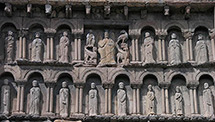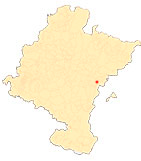The Gateway of Santa María de Sangüesa
By Clara Fernández-Ladreda Aguadé
|
THE ARTISTS. THE WORKSHOP OF SAN JUAN DE LA PEÑA AND THE WORKSHOP OF SCHEMATIC FIGURES |
|
The upper frieze and the modillions of the cornice
The frieze, divided into two floors, is presided over by the Pantocrator or Maiestas Domini flanked by the Tetramorphos, a representation of the Vision of the supreme judge and his court described by Saint John in the Apocalypse (Rev. 4, 1-3 and 6-7), topic usually known as the Second Coming, because it refers reference letter to the second coming of Christ to earth at the end of time - the first took place when he was born in Bethlehem - to judge us. On both sides, under arcades, are the archangels Gabriel and Michael, who acted as plaintiffs and defenders on the day of judgement, who do not appear in the Johannine account but are ultimately taken from Byzantine art, although their immediate source must have been Catalan Romanesque painting, in which they are frequent. The Apostolate completes the ensemble, also under arcades, whose members often replace the twenty-four apocalyptic elders (Rev. 4:4) as companions of the supreme judge.
We are therefore faced with another version of the Last Judgement, different from that of the tympanum, since instead of depicting the Judgement itself with Christ passing sentence, separating the blessed from the damned and placing the former on his right in heaven and the latter on his left in hell, the prelude to the Judgement, i.e. the arrival of the judge, is staged. This is a more antiquated formula that is destined to disappear in the future, except in exceptional cases, while the tympanum formula will be prolonged into the Gothic period.
These friezes crowning the doorways, consisting of the Maiestas, the Tetramorphos and the Apostolate, are relatively frequent in the late Hispanic Romanesque, especially Spanish. The only more original detail is the incorporation of the archangels.
The modillions that support the eaves are mostly decorated with animal motifs, generally heads, a very common theme in these elements. Exceptionally, two offer us human figures: a pair of fighters facing each other with bare hands in the typical "combat with equal weapons", a symbol of anger, and a shoemaker repairing a shoe, subjects that had already appeared in the lower part from which they are probably taken, although with a decrease in quality, B .












